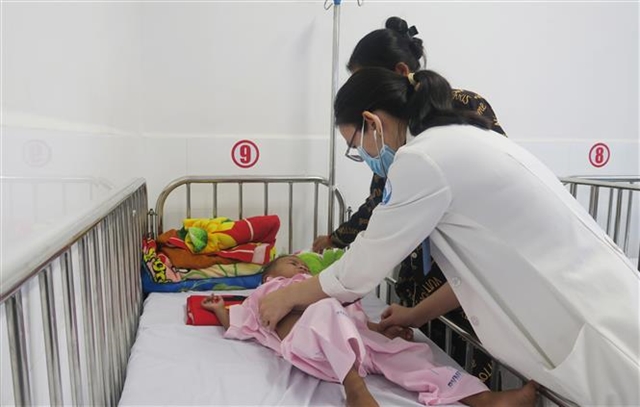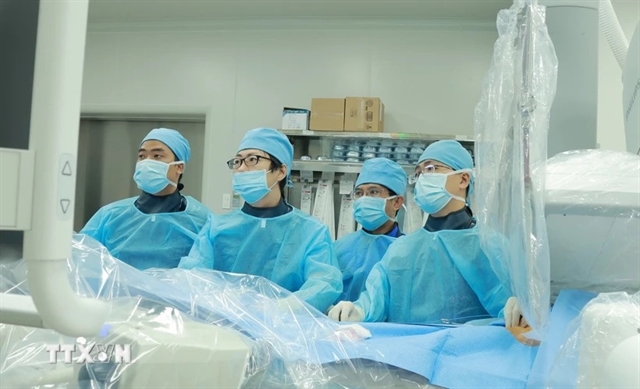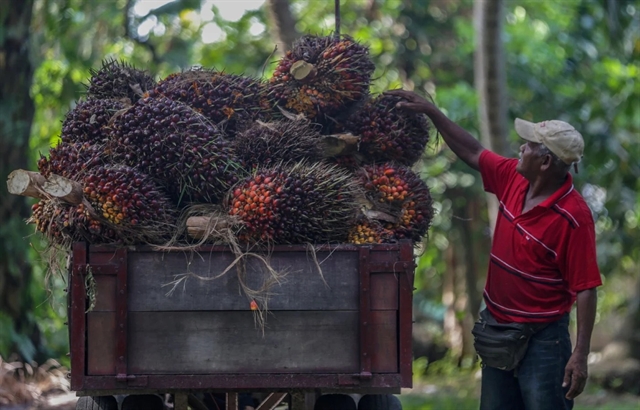 Society
Society

 |
| Doctors at Children’s Hospital 1 in HCM City perform surgery. — VNA/VNS Photo |
HCM CITY – Doctors at Children’s Hospital 1 in HCM City have successfully performed a rare percutaneous pulmonary valve replacement on a child with congenital heart disease, following prior surgical repair for heart defects.
L.Tr.Q, a 12-year-old boy from Quảng Ngãi Province, was born with Tetralogy of Fallot and underwent pulmonary valve replacement surgery when he was nineteen months old.
Over the past ten years, his health remained stable, however, starting in late 2023, he began experiencing frequent chest pains, especially during physical activity.
When he was examined at the hospital, doctors found that his pulmonary valve was no longer functioning effectively and needed to be replaced to prevent heart failure.
In the days before the Lunar New Year (Tết), the boy and his family travelled from Quảng Ngãi Province to HCM City for the second valve replacement procedure.
This time, instead of traditional open-heart surgery, doctors performed a minimally invasive catheter-based procedure — a modern intervention technique used in many developed countries.
According to Dr Lê Nguyễn Phú Quý of the hospital's Cardiology Department, this procedure involves inserting a catheter through the femoral vein and guiding it through the inferior vena cava to the right atrium, then to the right ventricle and pulmonary artery.
Doctors then select an appropriately sized artificial pulmonary valve, deliver it through the catheter to the pulmonary artery, and release it into the original pulmonary artery conduit.
Once deployed, the artificial valve functions like a normal heart valve.
Explaining the reason why patients require pulmonary valve replacement after previous Tetralogy of Fallot surgery, Dr Đỗ Thị Cẩm Giang from the Cardiology Department said that as children grow, their original valve often cannot handle the increased blood flow, leading to heart failure.
At this point, a new valve replacement becomes necessary to avoid a high risk of sudden death.
In the past, pulmonary valve replacement involved open-heart surgery, requiring a sternotomy, which is the procedure of cutting through the sternum.
However, this approach carries certain risks.
“Normally, the chest is protected by a layer of muscle and the thymus gland, but in children who have undergone prior heart surgeries, these structures are often removed, leaving the heart directly beneath the sternum. Thus, there is a risk of cutting into the heart during a sternotomy, which is extremely dangerous,” Giang said.
Additionally, open-heart surgery involves prolonged anaesthesia and recovery times, increasing the likelihood of complications.
Percutaneous valve replacement addresses these issues by eliminating the need for a major cardiac surgery, the doctor said.
This approach allows faster recovery, reduces hospitalisation time and minimises potential complications.
This technique is currently applied in many countries with advanced medical systems.
Children’s Hospital 1 is the first facility in Việt Nam to receive international certification to implement this technique.
The hospital began implementing percutaneous pulmonary valve replacement at the end of 2023.
However, the average cost of this procedure exceeds VNĐ600 million (US$25,000), which is not covered by health insurance.
As a result, only eight children have undergone the procedure in over a year, and fundraising efforts have supported this.
The technique has since been transferred to doctors at Bệnh viện E in Hà Nội and the University Medical Centre in HCM City.
According to Chu Huy Thành, head of the Social Work Department at Children’s Hospital 1, all eight cases required financial support from donors due to the high cost.
“We hope that this procedure will soon be included in the list of techniques covered by health insurance to reduce the financial burden on the families of patients,” he said. VNS




